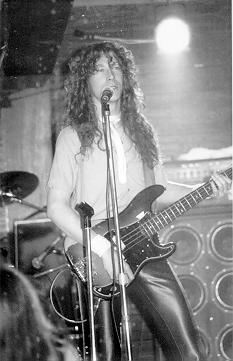Sunday, September 17, 2006
So, why do they call it a "skunk stripe"?
We played last night at a curling club in a small town about 40 minutes away. They set up a small stage in the middle of the rink, and we had about 175 people show up, drink and dance.
I took two basses (I always take two). One was the OLP fretted 5-string, the other was the black MIJ (Made in Japan) 4-string fretless Jazz. This is the dark twin to the white-finished model. The OLP is only one of two non-Fenders in the rotation. The other is the 5-string fretless mentioned in a previous post.
Neither of these basses has a skunk stripe. This is what they call the thin strip of darker-coloured wood in the back of the guitar or bass neck. Almost all necks are made of maple, and the back of the neck is routed out in order to install the metal truss rod. This is the very long adjustable bolt that run the length of the neck. It adds stability and strength and is used to add or remove relief (the forward or backward bend). I guess they use walnut or rosewood to make it really stand out, instead of using maple, which would only stand out a little.
With a maple fretboard on a maple neck, the neck would be one-piece, so you would have to make that route to get the truss-rod in. With a rosewood fretboard, you don't really need that back route since the rod can be installed from the front. So here's the strange part. In the early 70s, Fender started making almost all their necks with a skunk stripe, even the ones with rosewood fretboards. I guess it saved time and/or effort. Of course you can understand the all-maple necks needing one, but the others?
But here's the stranger part (or parts). The OLP is a maple fretboard, but has no stripe! These guys made the extra effort (actually, wouldn't it be less effort?) and routed from the front, then capped the neck with another piece of maple, and made it look very nice. That little touch was, for me, a big selling point. The MIJ fretless Jazz's also lack the stripe, despite being made in the mid-90s, long after Fender decided to take the easy road. I'll leave it to the reader to speculate about Japanese quality control.
The band played well, and we enjoyed the night. I messed up a couple of times while playing the 5-string, thinking that I was hitting an 'B' and instead hitting an 'F#', and then making a few more mistakes when I switched over to the fretless and still being in 5-string mode.
I took two basses (I always take two). One was the OLP fretted 5-string, the other was the black MIJ (Made in Japan) 4-string fretless Jazz. This is the dark twin to the white-finished model. The OLP is only one of two non-Fenders in the rotation. The other is the 5-string fretless mentioned in a previous post.
Neither of these basses has a skunk stripe. This is what they call the thin strip of darker-coloured wood in the back of the guitar or bass neck. Almost all necks are made of maple, and the back of the neck is routed out in order to install the metal truss rod. This is the very long adjustable bolt that run the length of the neck. It adds stability and strength and is used to add or remove relief (the forward or backward bend). I guess they use walnut or rosewood to make it really stand out, instead of using maple, which would only stand out a little.
With a maple fretboard on a maple neck, the neck would be one-piece, so you would have to make that route to get the truss-rod in. With a rosewood fretboard, you don't really need that back route since the rod can be installed from the front. So here's the strange part. In the early 70s, Fender started making almost all their necks with a skunk stripe, even the ones with rosewood fretboards. I guess it saved time and/or effort. Of course you can understand the all-maple necks needing one, but the others?
But here's the stranger part (or parts). The OLP is a maple fretboard, but has no stripe! These guys made the extra effort (actually, wouldn't it be less effort?) and routed from the front, then capped the neck with another piece of maple, and made it look very nice. That little touch was, for me, a big selling point. The MIJ fretless Jazz's also lack the stripe, despite being made in the mid-90s, long after Fender decided to take the easy road. I'll leave it to the reader to speculate about Japanese quality control.
The band played well, and we enjoyed the night. I messed up a couple of times while playing the 5-string, thinking that I was hitting an 'B' and instead hitting an 'F#', and then making a few more mistakes when I switched over to the fretless and still being in 5-string mode.
